| Structure | Name/CAS No. | Articles |
|---|---|---|
 |
β-Endorphin (30-31) (human)
CAS:7412-78-4 |
|
 |
Aceglutamide
CAS:2490-97-3 |